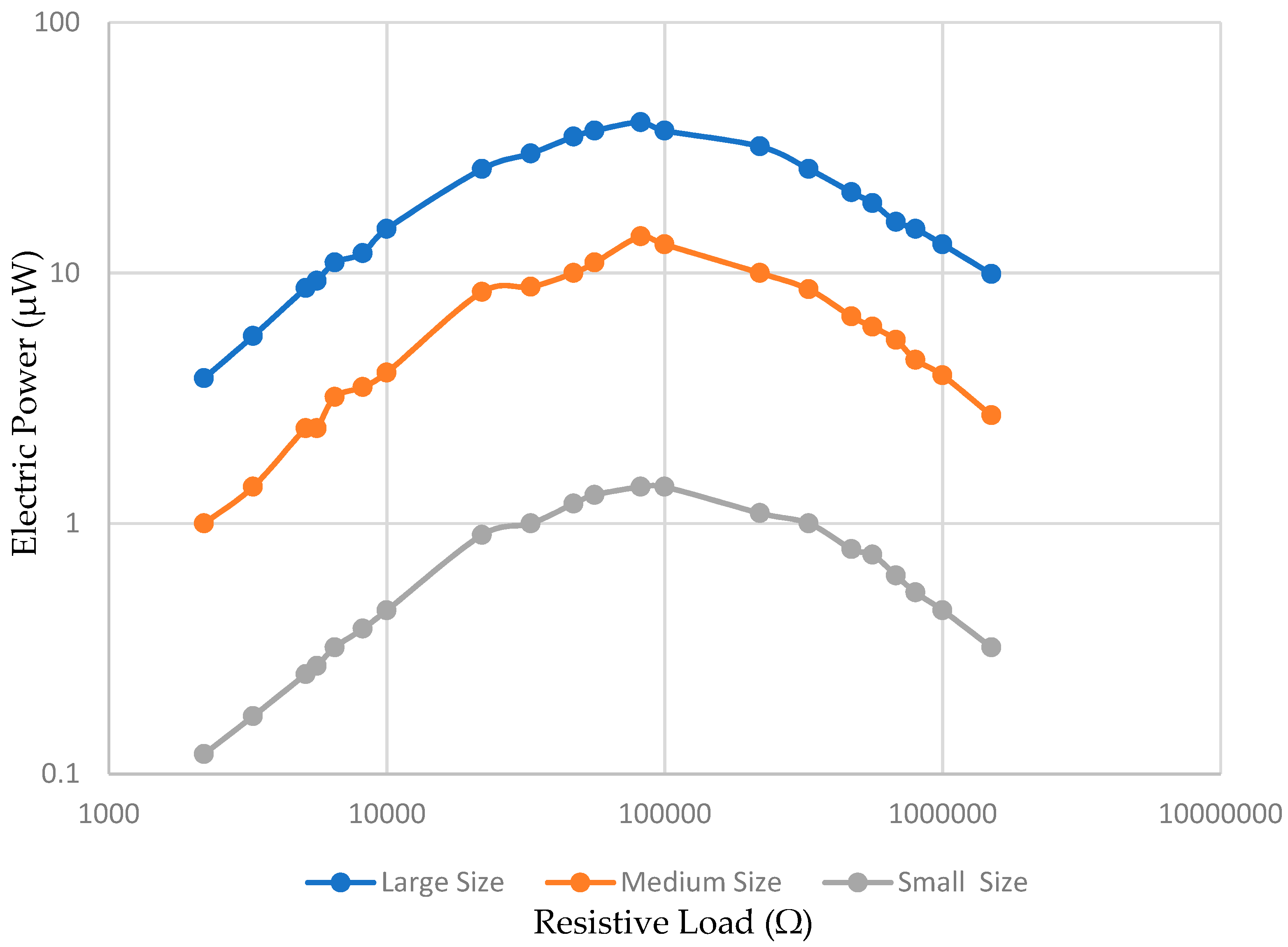Low-Cost Piezoelectric Sensor Characterization for Energy Harvesting Applications †
Abstract
:1. Introduction
2. Cantilever and Piezoelectric Sensor
3. Experimental Setup
4. Results and Discussion
5. Conclusions
Author Contributions
Conflicts of Interest
References
- Inman, D.J.; Erturk, A. Piezoelectric Energy Harvesting; John Wiley & Sons: Hoboken, NJ, USA, 2011. [Google Scholar]
- Beeby, S.; White, N. Energy Harvesting for Autonomous Systems; Artech House: Norwood, MA, USA, 2010. [Google Scholar]
- Priya, S.; Inman, D.J. Energy Harvesting Technologies; Springer: Berlin/Heidelberg, Germany, 2009; Volume 21. [Google Scholar]
- Roundy, S.; Wright, P.K.; Rabaey, J.M. Energy Scavenging for Wireless Sensor Networks; Springer: Berlin/Heidelberg, Germany, 2003. [Google Scholar]
- Khan, A.; Abas, Z.; Kim, H.S.; Oh, I.-K. Piezoelectric thin films review of transducers and energy harvesting. Smart Mater. Strut. 2016, 25, 1–16. [Google Scholar] [CrossRef]
- Caliò, R.; Rongala, U.B.; Camboni, D.; Milazzo, M.; Stefanini, C.; Petris, G.; Oddo, C.M. Piezoelectric energy harvesting solutions. Sensors 2014, 14, 4755–4790. [Google Scholar] [CrossRef] [PubMed]
- Uchino, K. The development of piezoelectric materials and the new perspective. In Advanced Piezoelectric Materials; Woodhead Publishing: Cambridge, UK, 2010; pp. 1–85. [Google Scholar]
- Zhang, S.; Li, F.; Jiang, X.; Kim, J.; Luo, J.; Geng, X. Advantages and challenges of relaxtor-PbTiO3 ferroelectric cristals for electroacoustic transducers—A review. Prog. Mater. Sci. 2015, 68, 1–66. [Google Scholar] [CrossRef] [PubMed]
- Dietl, J.M.; Garcia, E. Beam shape optimization for power harvesting. J. Intell. Mater. Syst. Struct. 2010, 21, 633–646. [Google Scholar] [CrossRef]
- Goldschmidtboeing, F.; Woias, P. Characterization of different beam shapes for piezoelectric nergy harvesting. J. Micromech. Microeng. 2008, 18, 1–7. [Google Scholar] [CrossRef]
- Ayed, S.B.; Abdelkefi, A.; Najar, F. Design and performance of variable-shaped piezoelectric energy harvesters. J. Intell. Mater. Syst. Struct. 2013, 25, 174–186. [Google Scholar] [CrossRef]
- Park, J.; Lee, S.; Kwak, B.M. Design optimization of piezoelectric energy harvester subject to tip excitation. J. Mech. Sci. Technol. 2012, 26, 137–143. [Google Scholar] [CrossRef]
- Rupp, C.J.; Evgrafov, A.; Maute, K. Design of a energy harvesting systems: A topology optimization approach based on multilayers plates and shell. J. Intell. Mater. Syst. Struct. 2009, 20, 1923–1939. [Google Scholar] [CrossRef]
- Yang, Z.; Wang, Y.Q.; Zuo, L.; Zu, J. Introducing arc-shape piezoelectric elements into energy harvesters. Energy Convers. Manag. 2017, 148, 260–266. [Google Scholar] [CrossRef]
- De Freitas, E.S.; Baptista, F.G.; Budoya, D.E.; de Castro, B.A. Equivalent circuit of piezoelectric diaphragms for impedance-based structural health monitoring applications. IEEE Sens. J. 2017, 17, 5537–5546. [Google Scholar] [CrossRef]
- Castro, B.A.; Clerice, G.A.; Andreoli, A.L.; de Souza Campos, F.; Ulson, J.A. A low cost system for acoustic monitoring of partial discharge in power transformer by Piezoelectric Sensor. IEEE Lat. Am. Trans. 2016, 7, 3225–3231. [Google Scholar] [CrossRef]
- Budoya, D.; Castro, B.D.; Campeiro, L.; Silveira, R.D.; Freitas, E.D.; Baptista, F. Analysis of Piezoelectric Diaphragms in Impedance-Based Damage Detection in Large Structures. Proceedings 2018, 2, 131. [Google Scholar]
- De Castro, B.A.; de Melo Brunini, D.; Baptista, F.G.; Andreoli, A.L.; Ulson, J.A. Assessment of macro fiber composite sensors for measurement of acoustic partial discharge signals in power transformers. IEEE Sens. J. 2017, 17, 6090–6099. [Google Scholar] [CrossRef]




| Sensor’s Size | Active Diameter (cm) | Maximum Electric Power (µW) | Maximum Density Electric Power (µW/cm2) |
|---|---|---|---|
| Large | 2.1 | 40 | 11.55 |
| Medium | 1.7 | 14 | 6.17 |
| Small | 0.9 | 1.4 | 2.20 |
© 2019 by the authors. Licensee MDPI, Basel, Switzerland. This article is an open access article distributed under the terms and conditions of the Creative Commons Attribution (CC BY) license (https://creativecommons.org/licenses/by/4.0/).
Share and Cite
Junior, P.A.F.; Campos, F.d.S.; Castro, B.A.d.; Ulson, J.A.C.; Baptista, F.G.; Andreoli, A.L. Low-Cost Piezoelectric Sensor Characterization for Energy Harvesting Applications. Proceedings 2019, 4, 25. https://doi.org/10.3390/ecsa-5-05749
Junior PAF, Campos FdS, Castro BAd, Ulson JAC, Baptista FG, Andreoli AL. Low-Cost Piezoelectric Sensor Characterization for Energy Harvesting Applications. Proceedings. 2019; 4(1):25. https://doi.org/10.3390/ecsa-5-05749
Chicago/Turabian StyleJunior, Paulo Afonso Ferreira, Fernando de Souza Campos, Bruno Albuquerque de Castro, José Alfredo Covolan Ulson, Fabrício Guimarães Baptista, and André Luiz Andreoli. 2019. "Low-Cost Piezoelectric Sensor Characterization for Energy Harvesting Applications" Proceedings 4, no. 1: 25. https://doi.org/10.3390/ecsa-5-05749
APA StyleJunior, P. A. F., Campos, F. d. S., Castro, B. A. d., Ulson, J. A. C., Baptista, F. G., & Andreoli, A. L. (2019). Low-Cost Piezoelectric Sensor Characterization for Energy Harvesting Applications. Proceedings, 4(1), 25. https://doi.org/10.3390/ecsa-5-05749






